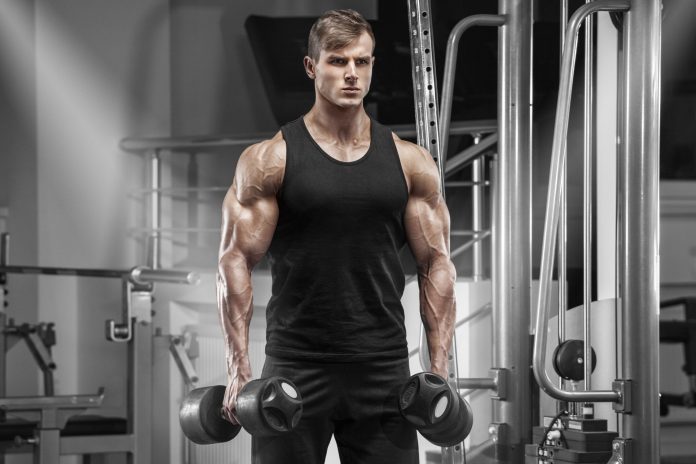Splitting your workouts into upper and lower body sessions is an excellent approach to training. It lets you achieve optimal muscle growth, provides flexibility for different goals, and doesn’t require excessive time commitments. Of course, you’ll get the best results from choosing exercises that work the majority of your muscles efficiently while ensuring balance. This means you should include push and pull moves both vertically and horizontally. Built With Science founder Jeremy Ethier has a great upper body workout plan that ticks these boxes, with options for both beginners and seasoned lifters. Of course, for full-body results, this upper body workout is best combined with a lower body workout session and rest days for recovery.
Weekly Routine
While you can work out any way you like, one of the most functional and effective methods is to split your week into upper and lower days, with adequate rest in between for muscle recovery. Jeremy suggests two upper body and two lower body workout sessions each week, with a rest after two consecutive days. It’s an excellent method if you have time constraints yet it is adaptable enough for individual goals. The suggested split is below, but you’re welcome to customize it for your schedule.
Best Upper Body Exercises
The ideal upper body workout should exercise the majority of your muscles in an efficient manner. As such, a good plan has four fundamental movements – a horizontal push, a horizontal pull, a vertical push, and a vertical pull. This program from Jeremy does that with the incline dumbbell press, chest supported row, shoulder press, and pull-ups. These four exercises are a great foundation and ideal for beginners to focus on. If you’re further along in your strength and fitness journey, you can add more isolating exercises to take your workout to another level. Another factor to consider is switching up your moves to encourage growth and so your muscles don’t get used to the same exercises. That’s why there are A and B alternatives for each so that you can mix and match.
Incline Dumbbell Press
Kick-off your upper body workout with an effective compound move for upper chest activation with an incline dumbbell press. This exercise has been shown to put more emphasis on the upper chest while also hitting your triceps. The benefits of using dumbbells over a barbell include a greater range of movement and preventing muscle imbalances. When setting up your incline bench, the most successful angle will be between 30 and 65 degrees, however, have a play around to see what angle best activates those chest muscles for you. Add this exercise to your Monday routine.
Execution
Recline on your bench, engaging your core and glutes, with feet flat on the floor for the best posture.
Hold a dumbbell in each hand, with an overhand grip.
Press the weights up towards the ceiling, leading with your thumbs for the most effective chest activations. Don’t let your shoulders round forward – keep your chest out.
Slowly lower your hands back, with control, to around chest height, with your elbows slightly behind your body.
Keep your shoulder blades retracted throughout the move, focusing on pulling back and down.
Sets: 4
Reps: 6-8
Rest: 2-3 minutes
Barbell Bench Press
On Thursday, switch out your Incline Dumbbell Press with a Barbell Bench Press instead. This is a fundamental move for a good chest workout. Because the pecs are fan-shaped, the alignment of your arms with your chest while you hold the barbell makes it an excellent move for targeting the mid and upper pectoral muscles, as well as the anterior deltoid and triceps. Finally, pick a weight that will challenge you, and employ the progressive overload scheme as you get stronger for continued growth.
Execution
Lay back on the bench while maintaining good posture – core and glute engaged and feet flat on the floor.
Hold your barbell in an overhand grip, with a grip wider than shoulder-width, ensuring your elbows bend at 90 degrees.
Driving into the bench, press the bar up to full extension.
Then, with control, lower the bar back down towards your chest – it should align with the middle of your sternum.
Sets: 4
Reps: 6-8
Rest: 2-3 minutes
Chest Supported Row
A chest-supported row is a powerhouse move that targets nearly all of the back musculature, including the traps, lats, rhomboids, teres major and minor, rear deltoids, and biceps. While a regular row is also excellent, one of the benefits of using an incline bench to support your body is that it minimizes the use of your lower back, letting you focus just on the upper. This is a great exercise to increase the width and thickness of your back. Add this to your Monday set.
Execution
Set up an incline bench, leaning forward at a significant angle, with your barbell set up underneath, within reaching distance.
Hold the bar in an overhand grip with your hands slightly wider than shoulder-width.
Pull the barbell towards your chest, focusing on pulling with your elbows and retracting your shoulder blades.
Try to keep your upper traps relaxed rather than in a shrugged position, so you maintain back activation.
Release the bar slowly back towards the floor until your arms are fully extended again.
Sets: 3
Reps: 8-10
Rest: 2 minutes
Barbell Row
Alternate your Monday’s chest supported row with a barbell row on Thursdays. The mechanics are similar, but this highly effective move will engage more muscles, including your lower back and core. One of the greatest aspects of a barbell row is its flexibility in achieving different goals by using different grips. For example, a wider, overhand grip will shift the focus towards the traps, rhomboid and rear delts, while a narrower grip will hit the lats more. Additionally, an underhand grip will also target the lats but with more bicep engagement. What you choose will depend on your goals and physique.
Execution
Stand with your feet slightly wider than hip-width apart, with the bar sitting over your midfoot.
Choose your preferred gip, and deadlift the weight up, so you’re in a standing position, being mindful to keep your spine neutral.
Shift your hips back slightly, keep your spine neutral, and bend your knees slightly.
Lower the weight down to just below knee height, or wherever your hamstring mobility stops without needing to round your back – ideally, this should be between a 45 to 15-degree angle.
While keeping your core engaged, pull the barbell up towards your torso, focusing on driving your elbows back and contracting your shoulder blades. Where the bar touches your body will vary with grip and angle, but it can be anywhere between your lower stomach and sternum.
Lower the bar with control and correct alignment, letting your shoulder blades naturally protract until you’re back in the starting position.
As you repeat the move, contract your triceps slightly to help maintain back engagement.
Sets: 3-4
Reps: 8-12
Rest: 2 minutes
Overhead Press
Moving onto the vertical pressing move for your Monday sessions is the overhead press. This killer move targets many muscles at once, primarily focusing on the anterior deltoid. However, it also works the triceps, lateral deltoids, serratus anterior, and activates the core. Plus, it’s easy to overload with weights, letting you build mass and strength more effectively. You can choose to do this either standing or sitting; however, standing will require more core engagement as your body seeks to stabilize against the movement.
Execution
Set your incline bench up to a sitting position, and hold the bar with your hands slightly wider than shoulder-width.
Focus on keeping your wrists straight and forearms vertical while holding the bar at the top of your shoulders, in the starting position.
Press the bar up vertically, fully extending your arms.
Try to keep your neck straight until the bar is over your head, at which time you can adjust.
Exhale as you lower the bar back down to the starting position, with control.
Sets: 3
Reps: 6-10
Rest: 2-3 minutes
Lateral Raises
An excellent alternative to the overhead press is lateral raises. This is the kind of exercise that gets all of your shoulder muscles working together to achieve your goals and build strength and mass in your shoulders. It also provides the most significant activation of the side delts, which gives you a really toned and defined look. However, you do need to focus on good form with this exercise, as it can place a lot of pressure and distress on the shoulder joint if not performed correctly. Poor posture can also engage the traps rather than the deltoids, which won’t give you the results you want. Add this exercise to your Thursday upper body workout.
Execution
Start with an athletic stance, which positions your feet just wider than hip-width, knees slightly bent, hips moved back a little, torso gently tilted forward, and chest up.
Hold the weights at your sides, with slightly bent elbows.
Raise the weight up to the side, but keep it just in front of your body, rather than straight out sideways. Doing so means it remains in the scapula plane of movement.
As you lift, point your thumbs slightly up, and don’t raise the dumbbell above your shoulder height.
Additionally, focus on not using a swinging motion to raise the weight, choosing a lower weight if necessary.
Use control and lower the weight back to the starting position. Use a lighter weight if you can’t control the descent.
Sets: 3
Reps: 6-10
Rest: 2-3 minutes
Pull-Up
Work all of your back muscles with a pull-up, an excellent vertical pulling exercise for your upper body. It works nearly every part of your back musculature, as well as your shoulders and biceps. This should be part of your Monday set and only requires your body weight. When doing pull-ups, one thing to keep in mind is that you don’t use a swinging motion to gain momentum – the whole point is to engage your upper body muscles. However, this is also a more fatiguing exercise, especially in combination with the previous moves. If you find this the case, or you’re a beginner who’s still building the strength for pull-ups, then lateral pull downs are an excellent alternative.
Execution
Grip the pull-up bar with a thumbless overhand grip, a little wider the shoulder-width apart.
Keep your core engaged and focus on decompressing your traps.
Pull yourself up until your head is above the bar, pulling with your elbows to maximize lat activation.
Ensure your shoulders don’t round out as you reach the top position.
Gently lower yourself back to the starting position.
Sets: 3
Reps: 8-10
Rest: 2-3 minutes
Lat Pulldowns
As mentioned, the best alternative to a pull-up for a vertical pulling exercise is lat pulldowns, which are the perfect addition to your Thursday upper body workout. It’s the ideal move to target the lats and the upper back but isn’t quite as fatiguing as a pull-up. It’s a great way to build both strength and mass, giving your physique that sought-after tapered V shape.
Execution
Sit facing the pulley machine with your feet planted firmly on the floor, spine straight, and core engaged.
Have the bar set at a height that you can comfortably hold with your arms outstretched.
Use a wide-set overhand grip to hold the bar, and pull it down towards the top of your chest.
Focus on squeezing your shoulder blades together and bringing your elbows down as far as possible without extending them behind you.
Slowly release the bar back to the starting position, using control to avoid the weight crashing back down.
Sets: 3
Reps: 8-10
Rest: 2-3 minutes
Incline Dumbbell Curls
An incline dumbbell curl is a more isolated move that specifically targets the long head of the bicep. One of the main benefits of curling in the slightly reclined position is that it forces the bicep to be active through the entire range of motion. If you’re looking for alternatives for your second session, you can choose a different kind of curl that emphasizes the short head, such as concentration, spider, or preacher curls.
Execution
Set your incline bench up, so you’re reclined between 50 and 60 degrees when you sit.
Hold the dumbbells in each hand, with your palms facing up and your hands slightly behind your body.
Curl your hands up until your biceps are fully contracted, which should be around chest height.
Lower the weights back, with control, until you’re in the starting position again.
You can increase the intensity by squeezing your triceps at the bottom, which will maximize the stretch along the bicep.
Sets: 2
Reps: 8-12
Rest: 2 minutes
Overhead Triceps Extensions
Also known as skull crushers, overhead tricep extensions are brilliant for targeting the triceps. Working your triceps like this gives you better shoulder extension, which in turn puts more emphasis on the long head of the muscle, which can be neglected in other moves. It’s good because it takes the tricep through its full range of motion from extension to contraction.
Execution
Lie down flat on your workout bench, ensuring your feet are flat on the floor, with core and glutes engaged.
Hold the dumbbells just behind the top of your head, with your elbows tucked in.
Carefully lift the weights towards the ceiling until your arms are perpendicular to your torso.
Slowly (and carefully – you don’t actually want to crush your skull) lower the weights back down to the starting position, where you would feel an excellent stretch along your tricep.
Sets: 2
Reps: 10-15
Rest: 2 minutes
Face pulls
The final exercise for your advanced upper body workout is face pulls. This is a brilliant move that will ensure you feel the burn throughout your upper back, including the traps, lateral and posterior delts, and teres minor. It’s also excellent for correcting muscle imbalances and improving your posture. Ideally, you’ll want to set the pulley to move from around head height and use a moderate amount of weight that will ensure a good contraction without needing momentum.
Execution
Stand square to the cable machine, in an athletic stance. Your feet should be wider than hip-width apart, with the torso straight and the core engaged.
Holding the ropes in both hands, pull the cables back towards your face, with your thumbs leading the way. You should finish near your ears, feeling a contraction between the shoulder blades.
Release the cable back while maintaining control until your arms are fully extended.
Sets: 2
Reps: 10-15
Rest: 1-2 minutes
Progressive Overload
The more consistently you work out, the stronger you’ll get. As such, your muscles will get used to the weights your using, so in order to build more strength as well as mass, you need to progressive overload your muscles. The exercises with an asterisk are ideal for using the double progression method, and you should focus on these exercises the most. Once you can comfortably do three sets of the maximum recommended reps at your chosen weight, increase the load the following week but drop the reps by around a quarter. If you can do this, continue building up to the full number of reps, and repeat the process. However, if you fail, simply reduce the weight down again and keep working at that load. Over time, you’ll continue to improve, getting stronger. However, it’s not always a linear progression, and you will naturally slow down eventually.































